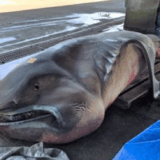No.3: Surinam Toad (Pipa pipa)

If you thought motherhood was beautiful, the Surinam toad might make you think twice. Native to the Amazon Basin, this flat, leaf-like amphibian breeds in a way that borders on body horror. After mating, the female embeds fertilized eggs into the skin of her back. Soon, her flesh swells into a honeycomb of pouches—each one an incubator for a growing embryo.
Weeks later, the horror show begins: dozens of fully formed baby toads burst out through the mother’s back and swim away. This grotesque yet effective strategy shields eggs and tadpoles from predators. With its pancake-flat body, star-shaped fingertips, and gaping mouth, the Surinam toad looks like something dredged from a sci-fi swamp. Equal parts creepy and awe-inspiring, it’s a chilling reminder that nature’s maternal instincts can take the strangest—and most unsettling—forms.
No.2: Tardigrade

The tardigrade, also called the water bear, is tiny—less than a millimeter long—but its toughness defies imagination. This microscopic creature laughs in the face of extremes that annihilate almost all other life. By entering a state called cryptobiosis, the tardigrade dries out, halts its metabolism, and essentially plays dead—only to bounce back when conditions improve.
In this state, it can endure:
・Absolute zero (-273°C) to boiling water
・Vacuum of space (surviving 10 days in orbit!)
・Crushing pressures 7,500 times greater than Earth’s atmosphere
・Radiation doses thousands of times the lethal human limit
When rehydrated, it resumes life as if nothing happened—even reproducing as normal. Scientists are still unraveling the secrets behind its indestructibility, including unique proteins that shield DNA from damage. The tardigrade isn’t just a biological curiosity—it’s a symbol of life’s sheer will to endure, rewriting our understanding of what survival really means.


